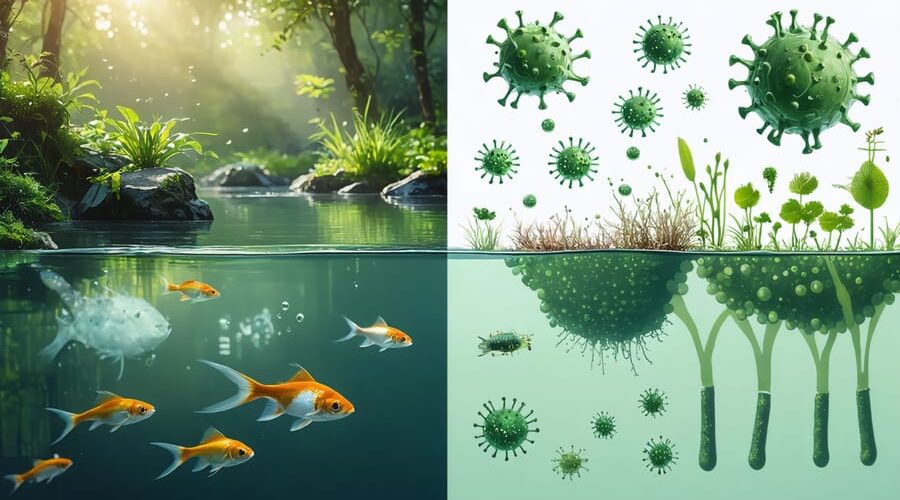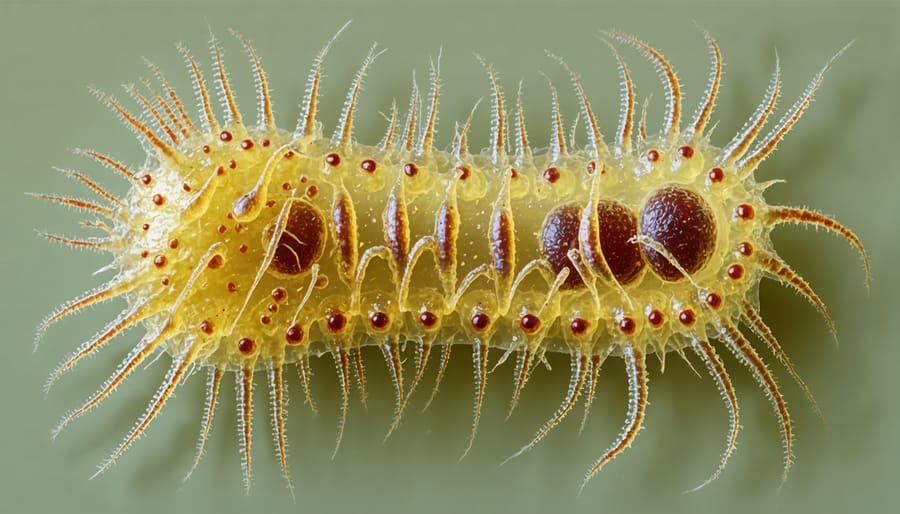
Hidden Threats in Your Pond: What Every Water Gardener Must Know About Emerging Pathogens
Emerging pathogens pose an increasingly urgent threat to pond ecosystems, demanding vigilant responsible aquatic management from every pond owner. From newly identified bacteria strains to evolving viral threats, these microscopic invaders can quickly transform a thriving water feature into a compromised environment. Recent studies have identified over 30 new aquatic pathogens in the past decade alone, with climate change and global water movement accelerating their spread. Understanding these emerging threats isn’t just about protecting your investment – it’s about safeguarding the delicate balance of your pond’s ecosystem and the health of its inhabitants. Whether you’re maintaining a backyard water garden or managing a larger aquatic feature, staying informed about these new pathogens and their prevention is crucial for long-term pond health and sustainability.
Common Emerging Pathogens in Pond Environments
Bacterial Threats
Several emerging bacterial threats have become increasingly concerning for pond owners in recent years. Aeromonas hydrophila, a common but potentially dangerous bacterium, can cause ulcers and fin rot in fish, particularly when water quality deteriorates. Another growing concern is Columnaris disease, caused by Flavobacterium columnare, which appears as cotton-like growths on fish and can spread rapidly through a pond population.
Plant pathogens are also on the rise, with bacterial leaf spot becoming more prevalent in aquatic plants. This condition appears as dark, water-soaked patches on leaves and can quickly devastate ornamental pond plants if left unchecked. Crown rot, another bacterial infection, affects plant roots and stems at the water line, causing severe damage to water lilies and other floating plants.
Temperature changes and increased organic matter in ponds can create perfect conditions for these bacteria to thrive. Regular water testing, proper filtration, and maintaining appropriate fish stocking levels are crucial preventive measures. Watch for unusual fish behavior, unexplained plant decay, or sudden changes in water clarity, as these could indicate bacterial problems requiring immediate attention.

Fungal Concerns
Fungal pathogens are becoming an increasing concern for pond owners, with several new species emerging that can affect both aquatic plants and fish. Water molds, particularly Saprolegnia and Pythium species, have been showing up more frequently in home ponds, often attacking fish eggs and causing cotton-like growths on plants. These fungi thrive in organic-rich environments, especially when water quality isn’t optimal.
Recent studies have identified new strains of Phytophthora, a particularly aggressive water mold that can devastate aquatic and marginal plants. This pathogen spreads rapidly in warm, stagnant conditions and can quickly move from one plant to another through the water.
To protect your pond from fungal issues, maintain good water circulation and regularly remove dying plant material. Keep an eye out for unusual spots on leaves, white fuzzy growths on fish or plants, or rapidly declining plant health. If you notice these signs, it’s crucial to act quickly by isolating affected specimens and improving water quality through proper filtration and regular maintenance. Consider using beneficial bacteria products to help maintain a healthy biological balance in your pond ecosystem.
Warning Signs and Early Detection
Visual Indicators
When monitoring your pond for emerging pathogens, several visual indicators can alert you to potential problems. Clear water suddenly becoming cloudy or taking on an unusual color, particularly green or brown, may signal pathogen growth. Watch for unexpected changes in fish behavior, such as lethargy, swimming near the surface, or gasping for air. These could indicate the presence of harmful organisms in the water.
Plant health is another crucial indicator. Keep an eye out for leaves that develop spots, become discolored, or start decaying unusually fast. Algae blooms that appear suddenly and spread rapidly might suggest an imbalance in the pond’s ecosystem, potentially creating conditions favorable for pathogens.
Observe your fish closely for physical signs like white spots, unusual growths, or frayed fins. The presence of dead fish or other aquatic life should prompt immediate investigation. Around the pond’s edges, watch for unusual foam, scum, or film on the water’s surface, as these can indicate pathogenic activity.
Remember that early detection through these visual cues allows for quicker response and more effective treatment, helping maintain your pond’s health and beauty.

Water Testing Methods
Testing your pond water for pathogens doesn’t have to be complicated. Most pond owners can perform basic testing at home using readily available test kits. Start with a simple water quality test strip that measures pH, ammonia, nitrites, and nitrates – these parameters can indicate conditions favorable for pathogen growth.
For more specific pathogen testing, collect water samples in clean, sterile containers from different areas of your pond, especially near the bottom and around plant zones. Many garden centers and pet stores offer specialized test kits that can detect common waterborne bacteria and parasites.
Consider using a microscope to examine water samples for visible organisms. While this won’t identify all pathogens, it can help spot potential problems before they become serious. Look for unusual cloudiness, floating particles, or strange colors in your water samples.
For comprehensive testing, send water samples to a local laboratory specializing in aquatic testing. They can provide detailed analysis and identify specific pathogens that might be present. It’s recommended to test your pond water at least quarterly, with additional testing if you notice any changes in water clarity or fish behavior.
Remember to keep a log of your test results to track changes over time and identify patterns that might indicate emerging problems.
Prevention and Protection Strategies
Water Quality Management
To effectively combat emerging pathogens, it’s crucial to maintain optimal water conditions in your pond. Regular monitoring of key parameters like pH, dissolved oxygen, and temperature creates an environment where harmful organisms struggle to thrive.
Start with a weekly testing routine using reliable test kits to check water quality. Aim to keep pH levels between 6.8 and 7.8, and ensure dissolved oxygen stays above 6 mg/L. Installing proper filtration systems and maintaining them regularly helps remove excess nutrients that pathogens feed on.
Adding beneficial organisms like certain bacteria and aquatic plants can naturally balance your pond’s ecosystem. These helpful microorganisms compete with pathogens for resources, making it harder for harmful organisms to establish themselves.
Don’t forget about water circulation – a well-placed pump or aerator prevents stagnant areas where pathogens typically multiply. Regular partial water changes (about 10-15% monthly) help dilute potential pathogen concentrations while maintaining stable water chemistry.
Remember, prevention is always easier than treatment. By keeping your pond’s water quality in check, you create a robust environment that naturally resists pathogen growth, saving time and effort in the long run.
Quarantine Procedures
Introducing new fish or plants to your pond requires careful quarantine procedures to prevent the spread of emerging pathogens. Always set up a separate quarantine tank or container filled with clean, dechlorinated water, maintaining similar temperature and water parameters to your main pond.
For fish, observe them in quarantine for at least 2-3 weeks. During this time, watch for signs of illness like unusual swimming patterns, loss of appetite, or visible parasites. It’s best to feed them in quarantine and monitor their eating habits and waste production. If possible, obtain new fish from reputable suppliers who regularly test for common pathogens.
When adding new plants, gently clean them to remove any snails, eggs, or debris. Trim away any dead or dying leaves and inspect the roots thoroughly. Dip the plants in a mild potassium permanganate solution or other appropriate plant-safe disinfectant. Keep plants in a separate container for 1-2 weeks, checking for any signs of disease or pest infestation.
During quarantine, use separate equipment (nets, buckets, gloves) for the quarantine area to avoid cross-contamination. If you notice any health issues, extend the quarantine period and consider treating with appropriate medications before introducing specimens to your main pond. Remember, while quarantine might seem time-consuming, it’s much easier than dealing with a full-blown pathogen outbreak in your established pond ecosystem.

When to Seek Professional Help
While many pond issues can be managed independently, certain situations require professional expertise. If you notice multiple fish deaths within a short period, unusual water discoloration that persists after regular maintenance, or strong, unpleasant odors emanating from your pond, it’s time to contact a specialist. Additionally, seek professional help if you observe recurring algal blooms despite following proper maintenance protocols or if your fish show signs of distress like gasping at the surface or unusual swimming patterns.
Professional intervention is also warranted when your water quality tests consistently show abnormal readings, particularly if pH levels fluctuate dramatically or dissolved oxygen levels remain low despite corrective measures. If you’ve identified potentially harmful pathogens but standard treatments aren’t effective, a pond specialist can provide targeted solutions and prevent further spread.
Consider professional assistance if you’re planning major changes to your pond ecosystem or introducing new species, as these modifications can impact pathogen dynamics. Experts can assess your pond’s overall health, identify potential vulnerabilities, and recommend preventive measures specific to your situation. They can also provide guidance on upgrading filtration systems or implementing advanced treatment methods when necessary.
Don’t hesitate to consult professionals if you’re unsure about handling any situation. Early intervention can prevent more serious problems and help maintain a healthy pond ecosystem.
Staying informed about emerging pathogens is crucial for maintaining healthy and vibrant ponds. As we’ve explored, these microscopic threats can pose serious risks to aquatic life, plant health, and even human safety. Regular monitoring, proper maintenance, and swift action when issues arise are your best defenses against these invisible invaders.
Remember that prevention is always better than cure. By maintaining proper water quality, ensuring adequate filtration, and following recommended cleaning procedures, you can significantly reduce the risk of pathogen outbreaks in your pond. Keep a watchful eye for any unusual changes in water appearance, fish behavior, or plant health, as these can be early warning signs of pathogen presence.
Don’t hesitate to reach out to local pond experts or water testing services if you notice concerning changes. The world of aquatic pathogens is constantly evolving, and staying connected with the pond community can help you stay ahead of new threats. With proper knowledge and vigilance, you can keep your pond ecosystem thriving and protect your aquatic friends for years to come.
